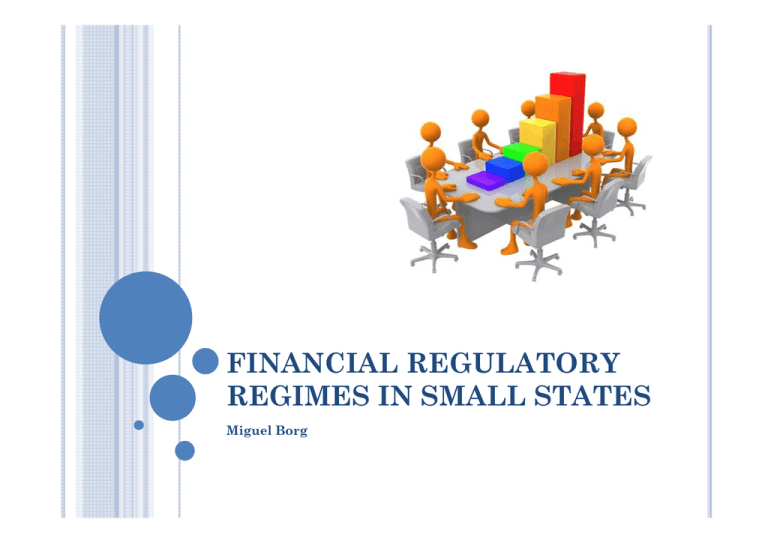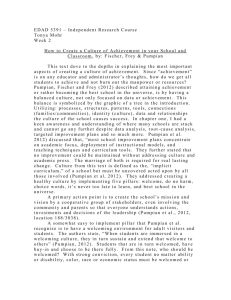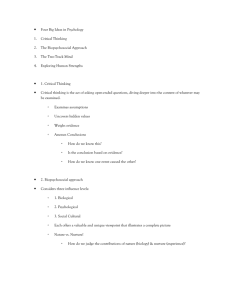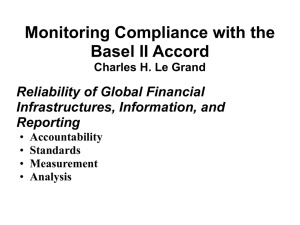FINANCIAL REGULATORY REGIMES IN SMALL STATES Miguel Borg
advertisement

FINANCIAL REGULATORY REGIMES IN SMALL STATES Miguel Borg The Three Pillars of Basel II STABILITY SOUNDNESS SAFETY Pillar 1: Minimum Capital Requirements Pillar 2: Supervisory Review Process Pillar 3: Market Discipline Basel II – Capital Charge Unchanged Tier 1 + Tier 2 +Tier 3 Risk Weighted + Assets > 12.5 x capital charge for Market Risk & Operational Risk Unchanged Credit Risk New element Unchanged Major change 8% Basel II: Details of Pillars Operational Risk Market Risk Credit Risk Standardized Approach Internal Ratings Based Approach Foundation Approach Advanced Approach Standardized Approach Internal Measurement Approach Basic Indicator Approach Standardized Approach Internal Measurement Approach Supervisory Review Market Discipline Pillar 1 – Credit Risk: Standardised Approach Credit Quality Fitch S&P Moody's 1 2 3 4 5 6 AAA to AAA+ to ABBB+ to BBBBB+ to BBB+ to BCCC+ > Unrated AAA to AAA+ to ABBB+ to BBBBB+ to BBB+ to BCCC+ > Aaa to Aa3 A1 to A3 Baa1 to Baa3 Ba1 to Ba3 B1 to B3 Caa1 > Sovereign Corporate 0% 20% 50% 100% 100% 150% 100% 20% 50% 100% 100% 150% 150% 100% Institution < 3 months > 3 months 20% 20% 20% 50% 20% 50% 50% 100% 50% 100% 150% 150% 20% 50% Pillar 1 – Credit Risk: Internal Rating Based Approach Expected Loss Unexpected Loss Stress Loss Pillar 1 – Credit Risk: Internal Rating Based Approach Customer Related Expected Loss EL = = Loan Related Probability of Default x Loss Given Default PD x LGD x x Exposure at Default EAD Pillar 1 – Credit Risk: Internal Rating Based Approach VAR Expected Loss Unexpected Loss Stress Loss Covered by Capital Covered by ‘Insurance’ Included in Pricing Covered by Provisions Pillar 1 – Credit Risk: Internal Rating Based Approach 99.95% VAR confidence level VaR Total Loss incurred at 99.95% confidence level = EUR 6000 Expected Loss EUR 1000 Expected Loss, Provisions/Pricing Unexpected Loss Economic Capital EUR 5000 Stress Loss Losses remote = no capital cover Pillar 1: Market Risk Market risk is defined as “the risk of losses in on and off-balance-sheet positions arising from movements in market prices.” Market Risk Amendment 1996 Interest Rate Risk Equity Position Risk Foreign Exchange Risk Commodities Risk Options VaR is a single number (currency amount) which estimates the maximum expected loss of a portfolio over a given time horizon and at a given confidence level. Pillar 1: Operational Risk “Operational risk is defined as the risk of loss resulting from inadequate or failed internal processes, people and systems or from external events. The definition includes legal risk* but excludes strategic and reputational risk.” Basel II § 644 * legal risk includes, but is not limited to, exposure to fines, penalties, or punitive damages resulting from supervisory actions, as well as private settlements. Pillar 1: Operational Risk Source: BIS Part B: Pillar 2 “Banks should have a process for assessing overall capital adequacy in relation to risk profile and a strategy for maintaining capital levels” ICAAP Assess all material risks and identify any weaknesses in the internal governance Identify amount and quality of internal capital in relation to risk profile, strategies and business plan Produce ICAAP number and assessment ICAAP - Risk Coverage 1. Pillar 1 risks 2. Risks not fully captured under pillar 1 (e.g. residual risk of credit risk deriving from risk mitigation techniques, securitisation risk, model risk) 3. Risks to be covered under pillar 2 (interest rate risk in the banking book, concentration risk, etc.) 4. External factors (risks deriving from the economic and regulatory environment, risks resulting from the business performance of the institution) 5. Internal governance and oversight functions Concentration Risk Diversification Internal IRRBB Liquidity Risk PILLAR 2 Risk Exposures Reputational & Strategic Risk PILLAR 2 Governance Internal Governance Risk Mitigants Controls & Oversight Residual Risk External Environment Operational Risk Market Risk PILLAR 1 Credit Risk PILLAR 2 Regulatory Capital PILLAR 1 PILLAR 1 SREP – BR/12 Pillar 2: Capital Allocation 450,000 400,000 400,000 350,000 Surplus 350,000 300,000 Stress Testing 300,000 Tier 2 250,000 250,000 IRRBB 200,000 200,000 150,000 Tier 1 Concentration Risk 150,000 100,000 Operational Risk 100,000 50,000 Credit Risk 50,000 0 -50,000 - Illustrative Purpose Only Basel III Source: Basel III: A global regulatory framework for more resilient banks and banking systems. Basel III: International framework for liquidity risk measurement, standards and monitoring. Objectives: o Raising the quality, consistency and transparency of the capital base o Enhancing risk coverage o Supplementing the risk-based capital requirement with a leverage ratio o Reducing procyclicality and promoting countercyclical buffers o Addressing systemic risk and interconnectedness Basel III There are nine key breakthroughs in Basel III as follows: • • • • • • • • • The numerator of the capital puts focus on tangible common equity, the highest-quality component and the greatest loss-absorbing capacity. Eradicate the trading book loophole, i.e. eliminate the possibility of regulatory arbitrage between the banking and trading books. A sevenfold increase in the common equity requirement for internationally active banks. Banks will no longer be able to pursue distribution policies that are inconsistent with sound capital conservation principles. Risk-based framework but includes a Tier 1 leverage that captures risks arising from total assets. The introduction of a countercyclical capital to mitigate the procyclicality. SIFIs need a higher loss-absorbing capacity to reflect the greater risks that they pose to financial system. The attempt to address the “too connected to fail” problem. Supervisors should avoid over-reliance on banks’ internal models, and their supervision needs to be more intrusive to ensure that systemic risk and tail events are adequately captured in banks’ risk modeling and stress testing. Significant increase the required level of capital Basel III – Tier 1 Calculation Tier 1 Capital Requirements = 14 2.5? 12 [Minimum Capital Ratio] + 10 [Capital Conservation Buffer] + 8 [Countercyclical Capital Buffer] + 6 [Capital for Systemically Important Banks] 4 2.5 2.5 6.0 2 0 1 Phase-in Arrangements 14.5 14.0 13.5 13.0 12.5 12.0 11.5 11.0 10.5 10.0 9.5 9.0 8.5 8.0 7.5 7.0 6.5 6.0 5.5 5.0 4.5 4.0 3.5 3.0 2.5 2.0 1.5 1.0 0.5 0.0 13.5% 11.63% 9.75% 7.88% 2.5% 0.63% 1.25% 1.88% 2017 2018 6.0% 5.5% 4.5% 2010 2011 Minimum Tier 1 2012 2013 2014 Capital Conservation Buffer 2015 2016 Countercyclical Buffer 2019 Systemically Important Banks Basel III – New Requirements Capital Conservation Buffer The purpose of the conservation buffer is to ensure that banks maintain a buffer of capital that can be used to absorb losses during periods of financial and economic stress. While banks are allowed to draw on the buffer during such periods of stress, the closer their regulatory capital ratios approach the minimum requirement, the greater the constraints on earnings distributions (bonuses, dividend, buybacks). Capital Conservation Buffer (Common Equity) Countercyclical Capital Buffer A countercyclical buffer within a range of 0% – 2.5% of common equity or other fully loss absorbing capital will be triggered by regulatory authorities from time to time during periods of excessive aggregate credit growth in the economy which is indicative of systemic risks building in the national and international banking system. Banks that have a capital ratio that is less than 2.5%, will face restrictions on payouts of dividends, share buybacks and bonuses. The BCBS expects such buffer to be imposed infrequently, perhaps once every 10-20 years. Countercyclical Capital Buffer USA Norway Vertical shaded areas indicate the starting years of system wide banking crises. 1 The countercyclical buffer is 0 when the value of the credit/GDP gap is below 2 and 2.5 when it is above 10 per cent; for gaps between 2 and 10 percent the buffer is calculated as 2.5/8 times the value of the credit/GDP gap exceeding 2 per cent. SIFI Policy Framework o a resolution framework and other measures to ensure that all financial institutions can be resolved safely, quickly and without destabilising the financial system and exposing the taxpayer to the risk of loss, o a requirement that SIFIs and initially in particular global SIFIs (G-SIFIs) have higher loss absorbency capacity to reflect the greater risks that these institutions pose to the global financial system, o more intensive supervisory oversight for financial institutions which may pose systemic risk, o robust core financial market infrastructures to reduce contagion risk from the failure of individual institutions o other supplementary prudential and other requirements as determined by the national authorities. Thanks borgmiguel@gmail.com




